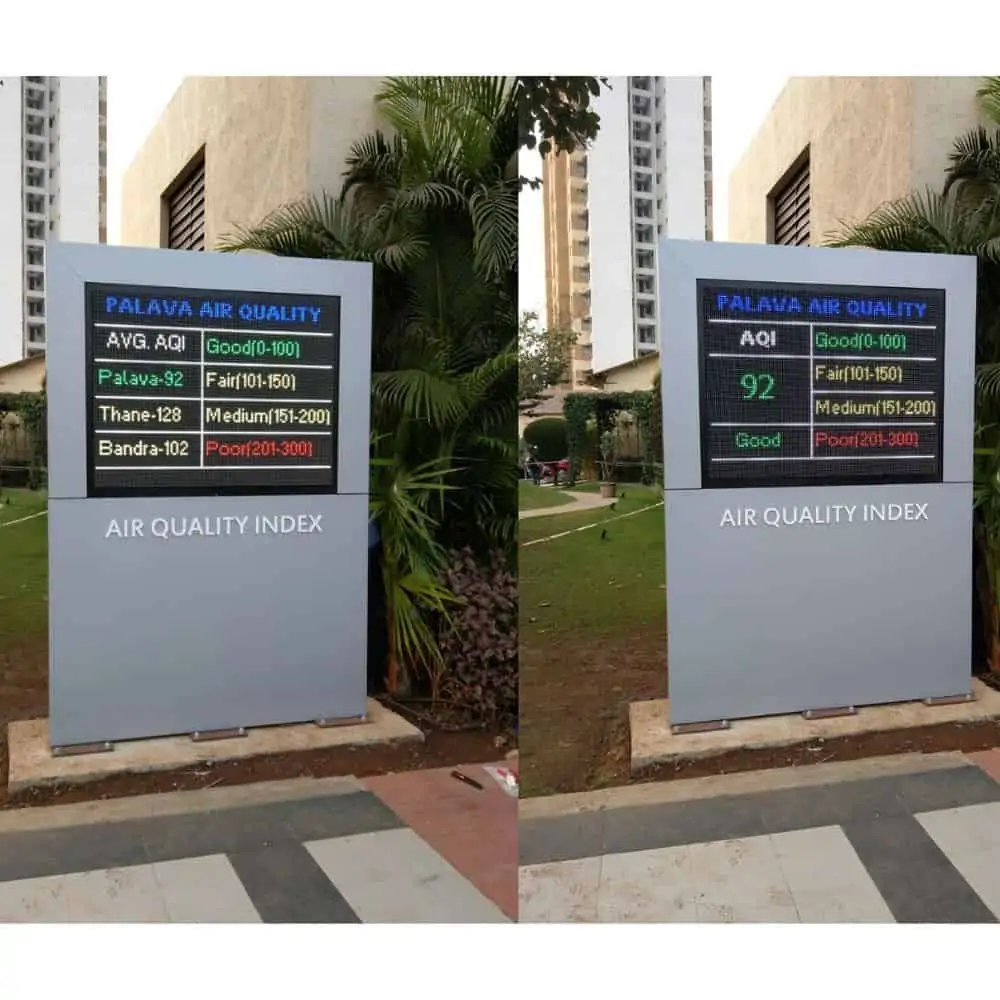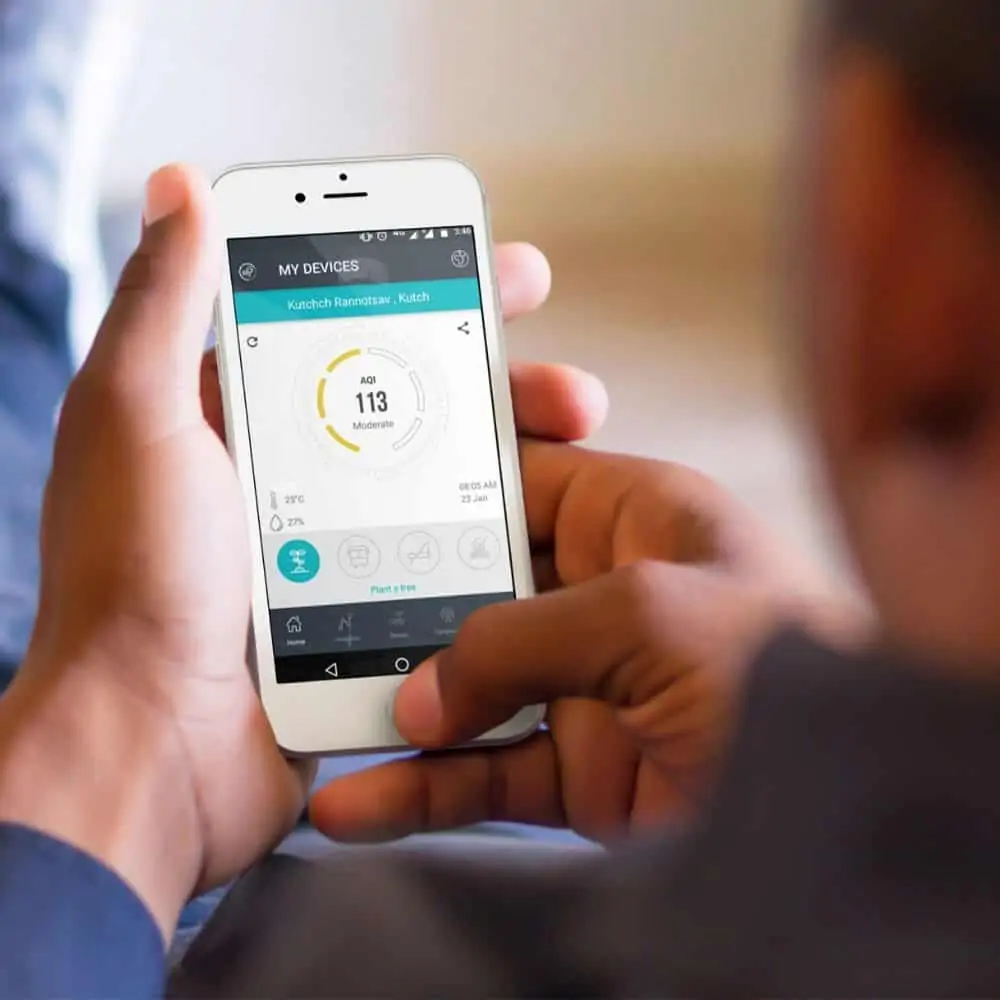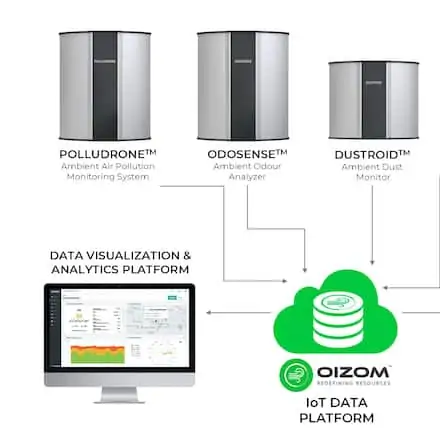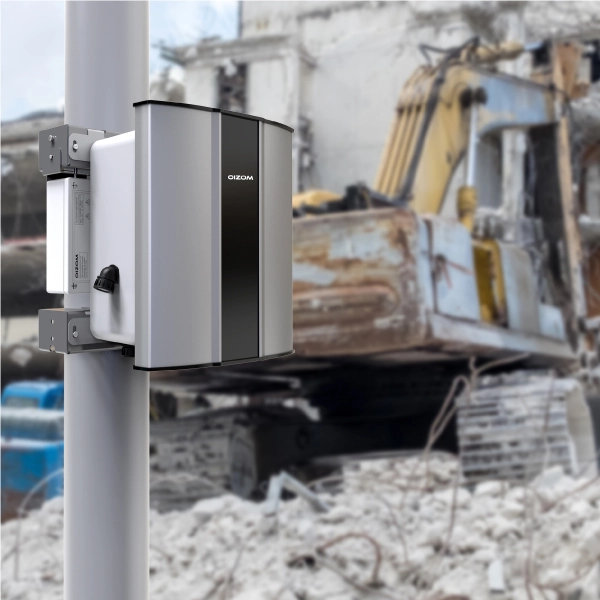The selection of air quality monitors plays an elemental role in preparing preventive and protective action plans on regional as well as global scales. In 2019, Hindustan Times kindled a discussion on the rising number of non-attainment cities across the country. That is to say, a non-attainment city fails to comply with the Central Pollution Control Board (CPCB) standards. This noncompliance is defined for a period of more than 5 consecutive years.
The National Clean Air Programme has listed 122 non-attainment cities across the country. To understand the extent of these pollution levels, monitoring is a crucial step. Moreover, a network of continuous air quality monitoring systems can provide datasets to indicate pollution hotspots. These air quality monitors further help in preparing policies and action plans; aimed at curbing those pollution levels.
Polludrone by OIZOM
OIZOM’s proprietary ‘e-breathing technology’ ensures higher accuracy. It provides meteorological data such as wind speed, wind direction, rainfall, flood levels, and visibility along with pollutant levels. Such a holistic approach yields superior data in terms of both consistency and quality. The e-breathing technology further eradicates external environmental disturbances to the process. This results in a 13% higher accuracy compared to industry standards.
Furthermore, there is a provision for attaching external modules to monitor flood, rainfall, and wind speed, however, these are optional and will depend on the need of the user. As a general rule, as these capabilities increase, systems tend to become less efficient and heavier, however with Polludrone’s strategic design and proprietary technology, it continues to be compact and lightweight. The integrated and hyperlocal data collection approach of Polludrone is, therefore, designed for deployment in a network, for monitoring in and around cities.
Primary features of an effective air quality monitor
Numerous aspects are to be taken into account for the selection of air quality monitors. Furthermore, OIZOM’s approach to achieving those objectives can be outlined in an array of themes;
Installation and Operational Ease – A compact system with easy startup, that is, just plugin, and the operation begins. In addition to that, the system’s ability to run independently on solar power is an advantage.
Reliability – The accuracy of data achieved from the monitoring process is very important. A 3 level calibration approach is, therefore, part of the standard procedure. This includes factory calibration for normal functioning, Lab calibration for higher data accuracy, and Collocation calibration on-site against a reference station. Moreover, higher accuracy achieved by OIZOM’s proprietary ‘Micro Active Sampling’ technology as compared to the passive sampling technology, provides highly credible data.
Accessibility – This data is easily accessible in an interactive manner through Oizom’s data visualisation and analytics software, Envizom. This is a user-friendly software that organizes the data. Furthermore, Real-time data is visualized through graphs and time series charts. In addition to that, geo-mapped visualizations are also generated for spatial analysis of the data collected.
Flexibility – Polludrone is capable of incorporating a modular sensor selection approach. This modular design allows a combination of different sensors to be used. The parameters that one device can measure are subject to customization depending on user needs.
Compatibility with multiple connectivity options (GSM / WiFi / LoRa / NBIoT / Ethernet) further increases ease of operation.
Product variants to facilitate prescribed data monitoring and analysis
The primary goal of these variants is to optimize the monitoring process. Therefore, the key difference, is not the technology, as the idea of variant development is to improve feasibility without compromising on the precision and accuracy of the air quality monitor. Thereby, proper selection of air quality monitors again comes into the picture because of the wide range of options available. This means ensuring the availability of specific features and subsequently, facilitate relevant data collection. This goes a long way in maintaining the economic feasibility of an already cost-effective system. Furthermore, such steps act as a positive incentive to monitor air pollutants on a spatially significant scale. Despite this, none of the variants, irrespective of the cost or scale of application, involve compromise on the sensor technology or the level of calibration checks conducted.
Key Functions of an Air Quality Monitoring System
The process of choosing a need-specific air quality monitoring system is a complex task. Achieving relevant data, therefore depends on certain considerations with respect to the device. Furthermore, an efficient and reliable air quality monitor should be capable of:
-
- Providing insights into pollutant concentration through dashboards
-
- Real-time monitoring, thereby, reducing potential errors that come with passive sampling
-
- Assisting in hotspot identification in terms of higher than usual concentrations
-
- Delivering highly reliable data through multi level caliberated sensors
State of the art approach to product development
The Research and Development team makes constant efforts in developing new technology that increases the accuracy and reliability of data. Additionally, the team also works towards making the monitor robust and user friendly. Certain upgrades to the existing Polludrone were introduced during the recent Pandemic. Three major improvements on the previous version:
-
- Communication – Users can now integrate Polludrone with industrial protocols like 4-20, MODBUS and CANBUS
-
- Easier SIM insert/replacement – Users can now isert or replace an existing SIM card without opening the enclsoure. This not only eases the process of GSM connectivity setup but also ensures easier troubleshooting.
-
- Data loss – Real-time data transfer can be hindered by certain problems such as loss of connectivity. Therefore, Polludrone now has an extended internal memory back up for a minimum of 3 months.
Feature Comparison
The selection of an air quality monitor includes looking at both the technical and economical viability of the product. The Polludrone by OIZOM is available in three variants – Lite, Smart, and Pro. Have a look at the table below for a brief comparison:
| Variant | Lite | Smart | Pro |
| Application | General | Extensive | Critical |
| Parameter Analyzed | PM2.5, PM10, CO2, CO, Noise, Light, UV-Radiation, Temperature, Humidity | PM10, PM2.5, CO2, CO, SO2, NO, NO2, O3, Noise, Light, UV-Radiation, Temperature, Humidity | PM1, PM2.5, PM10, TSP, CO2, CO, SO2, NO, NO2, O3, H2S, Noise, Light, UV-Radiation, Temperature, Humidity |
| AQI measurement compatible | Yes | Yes | Yes |
| Over the Air Update | Yes | Yes | Yes |
| 3 level calibration | Yes | Yes | Yes |
| External module | Yes | Yes | Yes |
Key Differences in Variant Applications
1. PM 1 data monitoring by Polludrone Pro
Moving from the Lite to Smart variant, the number of parameters analyzed increases. For instance, Polludrone Pro is capable of quantifying PM1 data. The particles with an aerodynamic diameter of less than 1 micron i.e ultra fine in nature are termedPM1. A major concern of highPM1 concentrations is its ability to penetrate deeper into the lungs before deposition, thereby posing public health concerns.
Application – With rising alarms over public health in the wake of the COVID 19 pandemic, it is becoming important to measure such particles in areas where people are most vulnerable. These areas might include hospitals, schools, mines, and so forth.
2. Polludrone Smart and Pro provide CO, UV-Radiation, and NOx data which are potential ground-level ozone precursors.
Application – According to the EPA, Ground Level Ozone is to be monitored and controlled for improving public health. A series of strategies are provided to restrict those emissions. A network of Polludrone Smart/Pro can provide data on ground-level ozone precursors. Moreover, this data will aid researchers to forecast future pollution levels and devise plans to curb them.
3. Generally, ambient air quality parameters do not include Carbon Dioxide. However, with rising concerns over warmer climates followed by thorough scientific assessments from the IPCC,CO2 monitoring has gained momentum.
Application – Urban areas are important with respect to carbon dioxide monitoring. The data derived from a network of monitors across the city can be used to develop mitigation solutions. According to C40, a network of city officials across the globe focused on addressing climate change, cities consume two-thirds of the world’s energy. Moreover, they account for 70% of the totalCO2 emissions. Hence, Polludrone pro is suitable for city-level monitoring and mitigation action plan development. It provides an efficient solution to monitorCO2 concentrations in ambient air along with data visualizations in real-time.
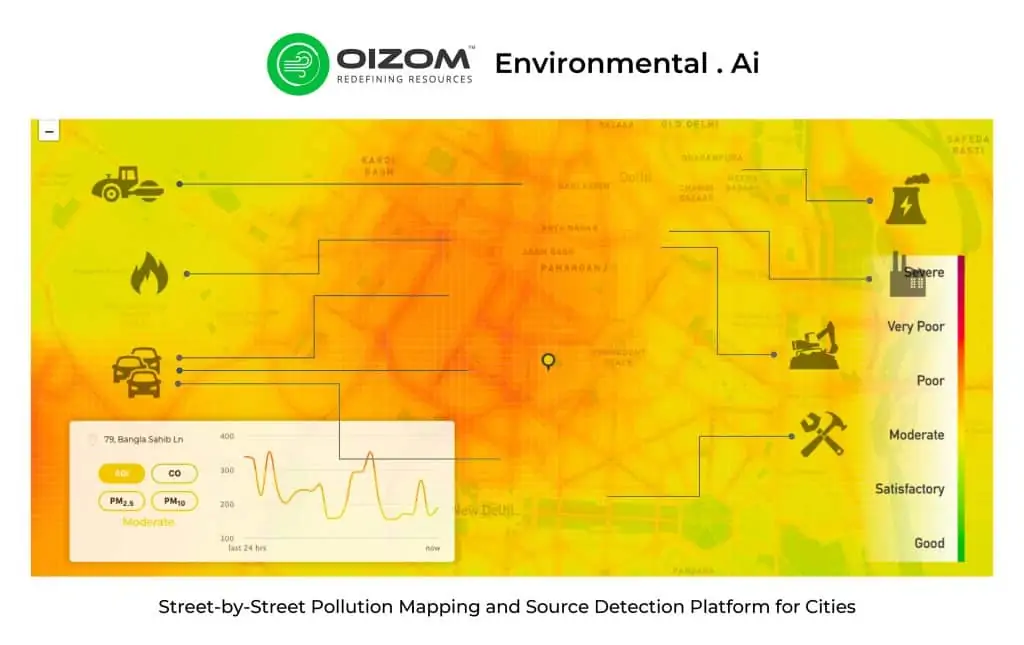
Considerations for selection of air quality monitors
-
- An efficient system must be able to provide pollutant trend analysis in real-time.
-
- Features that help impart concise air quality information to the general public is also a crucial aspect.
-
- Knowledge of pollutants which might be prominent in the area of installation should be given due consideration. Users can select Polludrone variant based on the parameter to be monitored. Eg. PM1 and PM100 is offered in the Polludrone Pro variant only.
-
- Calibration is an important aspect for effecticely monitoring the pollutant concentrations with accuracy.
Applications of Polludrone
-
- During winter, Polludrone installed in Kars, Turkey, is subjected to subfreezing levels i.e -20 ºC. Among such harsh conditions, the device efficiently monitored all the parameters.
-
- A network of Polludrone installed in Smart Cities such as Surat (Gujarat) and Varanasi (Uttar Pradesh) provides robust data collection across the city. The Identity and configuration feature, which allows geo tagging, helps maintain an inventory of the monitors installed. Furthermore, this aids in keeping precise records of the spatial extent of data monitored.
-
- Quantela deployed Polludrone for advocating automation in toll booth. This study focused on the effects of frequent breaking at toll booths and the resultant congestion of traffic. Furthermore, a real time air quality data on aVisual Messaging Display (VMD) made the vehicle drivers & toll booth staff aware.
